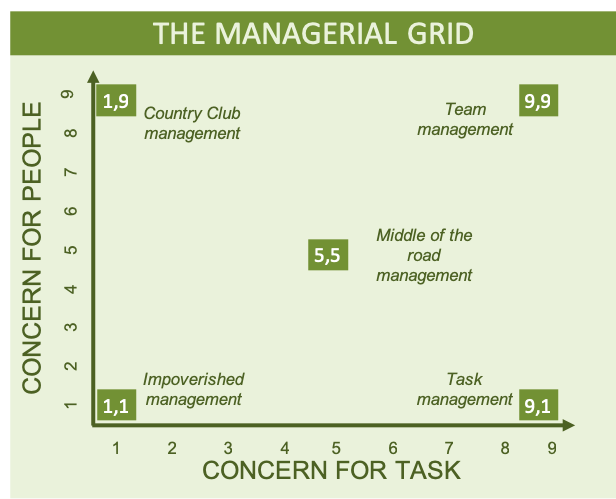Blake and Mouton’s Managerial Grid model says managers have two key areas of concern: people and tasks. Their levels of concern across these dimensions shape their management style. High concern for both leads to the best management.
Summary by The World of Work Project
The Managerial Grid
The Managerial Grid model says that leaders can be categorized based on how focused they are across two different dimensions: concern for production (completing tasks) and concern for people (supporting individuals).
In this model the best form of leadership (team management) occurs when high levels of concern are present for both people and tasks.

The Styles of Management
The managerial grid identifies five main styles of leadership, each dependent on a specific blend of concern for task and concern for people.
Where managers find themselves on the grid is a product of their prior experience, lessons they’ve learned from their role-models, the culture of their organization, personal style and the training and development they have received.
Impoverished Management
Impoverished management (AKA indifferent management) occurs when managers have little concern for the engagement of their teams or for completing tasks. Work is chaotic and disorganized. Nothing is achieved and no one is happy.
These managers should leave as they are probably not happy and they certainly are not making either their teams or their organizations happy.
Country Club Management
Country club management (AKA accommodating management) occurs when managers have lots of concern for their team’s engagement, happiness and wellbeing, but little for completing tasks. The hope of these managers is that their team’s engagement will lead to task completion, though this isn’t always the case.
These managers should maintain their concern for their people (perhaps relaxing it a bit if necessary) and increase their focus on task delivery. By doing so they will produce better results.
Middle of the Road Management
Middle of the road management (AKA status quo management) occurs when managers have balanced concern for engagement and completion of tasks, but not high levels of either. Performance is middling and there’s nothing much to say about these managers. It’s all just a little bland.
These managers should increase their concern in both areas. They might need to do this in stages, perhaps increasing task focus first, then people focus.
Task Management
Task management (AKA dictatorial management) occurs when managers have high levels of concern for task completion, but little for engagement. This may increase delivery in the short term, but ultimately reduces it as people cease to be engaged and motivated.
These leaders should increase their concern for people. This isn’t hard to do when you’re starting at this level, but some people still struggle to do so.
Team Management
Team management (AKA sound management) occurs when managers have both high people focus and high task task focus. These managers achieve the best results. They ensure delivery while retaining and engaging their people. These managers should keep doing what they’re doing.
Developing the Team Management Style
It’s possible to transition through the grid and to developed the high concern for both task and people that is required for the team management style. The journey starts with awareness, and takes some time and effort.
To develop in this direction, it’s important to spend some time on leadership and management development training, but it’s perhaps more important to develop your own self awareness and understand your own starting point fully.
The journey is also significantly shaped by the wider culture of the organization in question, and the leaders of that organization.
Learning More
You might be interested in learning more about the Seven Transformations of Leadership and Situation Leadership. You can also learn more about our favorite leadership framework, Authentic Leadership. We’ve even recorded a podcast on this which you can listen to below:
The World of Work Project View
This is a simple and useful way for managers and leaders to think about the need to balance the completion of tasks with the engagement of team members. It’s perhaps too simple really, but it’s still a useful tool for conversations around development and leadership style, as well as organizational requirements. It’s pretty similar to some of the framings that appear elsewhere, e.g. in Merrill Reid Social Styles.
Of course, managers knowing where they are on the grid is only half the battle. They then need to do something about it, and that’s the hard part. It’s a start though. Good leadership, coaching and cultures also help with those transitions.
Ultimately, managers will only move up and right if they are motivated to do so. And a lot of their motivation comes from how those managers are themselves led. If their senior leaders only care about getting the task completed, they’ll find it hard to be concerned for their people, and vice-versa.
How We Help Organizations
We provide leadership development programmes and consulting services to clients around the world to help them become high performing organizations that are great places to work. We receive great feedback, build meaningful and lasting relationships and provide reduced cost services where price is a barrier.
Learning more about who we are and what we do it easy: To hear from us, please join our mailing list. To ask about how we can help you or your organization, please contact us. To explore topics we care about, listen to our podcast. To attend a free seminar, please check out our eventbrite page.
We’re also considering creating a community for people interested in improving the world of work. If you’d like to be part of it, please contact us.
Sources and Feedback
This post is based on work done by Robert Blake and Jane Mouton. The best reference for this is their book: “The Managerial Grid III”.
We’re a small organization who know we make mistakes and want to improve them. Please contact us with any feedback you have on this post. We’ll usually reply within 72 hours.






